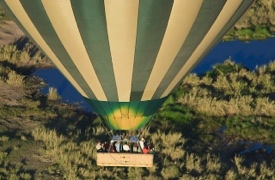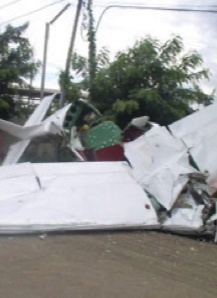Silencing Professional Pilots.Com
By Capt Nigel Pogmore
Former pilot & safety officer
Serengeti Balloon Safaris Ltd

IN THE NEWS "Fatal air crash of a forty-year-old fixed-wing Cessna Registration 5H-FUN (owned & registered in the name of Serengeti Balloon Safaris Ltd) in which two occupants were killed. One is the local pilot, Baraka; the other is 25-year-old Hayden Rowen from New Zealand. Three others sustained serious injuries".
Of the three injured, one young lady is from the UK, whilst others are from South Africa. The third casualty is a young local boy, who, unfortunately, was riding his bike in the area of the crash landing. Tony Pascoe gloatingly talks about how he has been able to give this young boy a hundred thousand Tanzanian shillings as compensation. I don't know the exchange rate. Thinking on my feet means that this equates to no more than $200.
The aircraft was well known to me to have suffered from engine problems (misfiring along with engine vibration) on the day in question; after a ground witness heard metallic screeching sounds coming from the low-flying Cessna, the engine cut out altogether. Subsequently, this resulted in the crash.
I attempted to find the New Zealand pilot, whom I believe had previously dumped this aircraft at an alternative landing site after becoming frustrated with perpetual engine problems. This, to me, seems to establish a trend of a " could-not-care-less attitude towards mechanical reliability, demonstrating a lack of appropriate safety culture.
Surprising, given that a metallic sound was coming from the engine just before it quit. Some may say it is highly suspicious that investigators failed to find any fault with the aircraft. Possessing a credible mechanical background raises concerns surrounding the integrity of the investigating authority. Confusingly, the AIB concludes that the cause of the crash was that the pilot executed a powerless turn rather than more appropriately, sighting the root cause of catastrophic engine failure. Having spent over 20 years in the aviation industry, the final conclusion reeks of unbridled impropriety.
Referring to the sound of metallic screeching leads me to ponder why the investigators never found any evidence that should have been in abundance in the way of score marks on rotating/ offending components. Later, at the time of my sacking, Pascoe gloats about being able to pay bribes to the aviation authority, which may well explain the suspicious air accident report.
The Pilot's history of fixed-wing aircraft shows a litany of incidents, including two incidences of wheels-up landings, diverting to Kilimanjaro International Airport in radio silence, in addition to inefficient instrument flying, however, further cementing the cause for suspicion of corruption having taken place; according to page 14 of the accident report, the deceased pilot's previously revoked licence was only revalidated eight months after his death.
.
I'd long since learned that Serengeti Balloon Safaris had another company just below Kilimanjaro. This was a skydiving adventure, and as the name suggests, we're talking about 10,000-foot tandem parachute jumps. Whilst commuting with Edward from Arusha to Moshi for my six monthly medical checkup, I was taken to see this facility. I was introduced to the locals who ran the office that interestingly housed in one of those oceangoing cargo containers. Just as I arrived, a young lady was getting ready to go for her parachute jump. She had just been weighed to make sure that she fell within the parameters before being attached to the jump master, Zach. I also met a young New Zealander, Hayden Ronan, who turned out to be the company's cinematographer; he was going to film this jump. They pointed towards the aircraft, which looked antiquated. A few jokes were passed around, with one comment saying that it is often referred to as the flying coffin. Apparently, it had been having engine trouble in the way of vibrations, etc. We were only at the airfield for about twenty to thirty minutes before continuing on with our journey.
We arrive at the doctor's surgery, it’s a small corner building. As soon as I enter, I’m met by two nurses, each wearing what were once white uniforms. I'm led to the doctor's room, soon as all the forms are filled out and, most importantly, fees are paid. He is a big fella sitting behind an old desk that has had the misfortune to lose a limb; a few books support one corner.
Stripping down to my underpants, I was instructed to lay face down on the bed. At this point, hot and cold rocks are placed on my back; I now have to inform the doctor as to which one is hot or cold. Next, he gets out a feather! I tell you, this was one the strangest medicals ever; yes, he tickles me with this state of the art medical equipment; he wants to see if I respond to feeling! “ giggles over, “that’s all okay” I got dressed. By now, the doctor is looking very proud of himself, having proven beyond reasonable doubt that I’m such a sensitive pilot! Obviously, a vital ingredient in Tanzania. Thinking to myself, this is what a class one medical is all about!
Next, he clamps on a headset attached to a box of tricks; all quite normal as I’m about to have a hearing test. All was going very well; then he shouted, “Did you not hear anything in your left ear?” “Well, not what you might want me to hear”, I replied. He says that my hearing is not good and may, in time, mean a failed medical. At that time, I pointed out that whilst he might be correct, I could hear the motorcycle that had been blasting fumes in through the open window for the past three minutes, “O, that’s good, congratulations, you have passed.” That brought the 7000 shilling class one aviation medical to a satisfactory conclusion, allowing me to return to base and continue flying.

A few weeks later, I was pleased to see that the parachute jump master whom I had met earlier had been given a balloon ride by our employers. I was the pilot that was going to take him along. Zach was a pleasant young South African guy, maybe no older than twenty-five. As one might expect from someone so adventurous, he was very outgoing. Later, during the celebratory champagne breakfast, Zack informed me of what had been going on back at the skydiving base
Sure, there was lots of normal company politics at play, so nothing unusual there; however, I was more concerned when he elaborated on the condition of the aircraft. It was green that he informed that the previous pilot had flown this aircraft to an alternative landing site after suffering repeated engine vibrations. By what I recall, I understand that this particular pilot had, had enough therefore decided to call it a day returning home to New Zealand.
A few weeks later, I was horrified to find out that this aircraft crashed just outside Moshi, killing the local pilot, Baraka, as well as the twenty-five-year-old New Zealander, Hayden Rowen. Ms Bolton, a young lady from the UK who was expecting to take her parachute jump, was seriously injured yet later transported back to the UK to undergo further treatment. Zack was a complete mess; weeks later repatriated to South Africa, where he eventually resumed his previous profession as a paramedic. However, this was only after he had relearnt to walk. From what I understand, he refuses to talk about his time as jump master in Tanzania.
Although the accident took place on 13 February 2008, it only came to my attention a few days later. I felt this was rather strange; however, Colin and Tony must have been in a state of panic back in the UK once the news arrived. I understand that Tony Pascoe flew out from the UK to oversee the aftermath of this accident. Two weeks later, he was in the Serengeti and seemed slightly disturbed by all the happenings. I sat and listened to all that had taken place. It turned out that the engine had cut out altogether and could not be restarted. At no time in our conversation was there any mention of the aircraft's unreliability issues; however, countless references were made to the fact that this aircraft had just that day returned after having its one hundred-hour check carried out in Dar es Salaam.
At the same time that all this was taking place, a relief balloon pilot Ramersis who was brought in from Belgium and was helping with flying duties. The same pilot was also a trainee helicopter pilot and had a good understanding of powered aircraft in general. Upon hearing about the accident, he was quite annoyed that this type of aircraft (a 40-year-old Cessna 172) was being used for parachuting. Apparently, he made some enquiries with his colleagues back in Belgium that reaffirmed that, in their view, this was a most inappropriate aircraft for this purpose, going on to claim that it may have struggled to cope with the payload and the repeated ascents to ten thousand feet.
With investigations underway, along with Tony departing the Serengeti, as far as I was concerned, that was the end of the matter. It was best to let the professionals get on with what needed to be done. While expecting heads to roll at that time, I had no reason to suspect any impropriety.
Cessna crashes in northern Tanzania, claims 2 lives, aerial ...eTurboNewshttps://eturbonews.com › News
eTurboNews
https://eturbonews.com › News
15 Feb 2008 — Arusha, Tanzania (eTN) - An “Aerial tourism flight” of Serengeti Balloon Safari experienced catastrophic engine failure on Wednesday ...
Accident number 4
More SBS passengers Killed
At Serengeti Balloon Safaris
Questions are raised
did he have a Pilot license ?